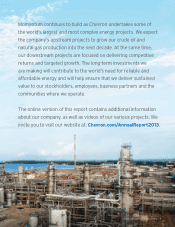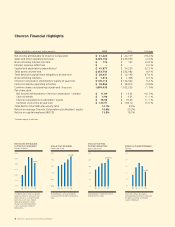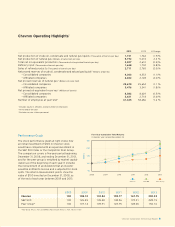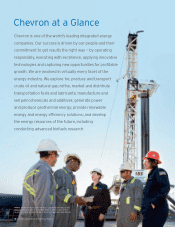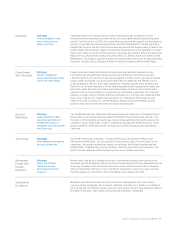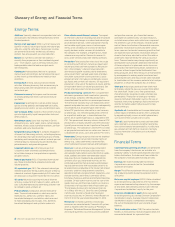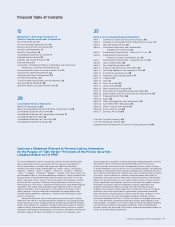Chevron 2013 Annual Report Download - page 13
Download and view the complete annual report
Please find page 13 of the 2013 Chevron annual report below. You can navigate through the pages in the report by either clicking on the pages listed below, or by using the keyword search tool below to find specific information within the annual report.
Chevron Corporation 2013 Annual Report 11
company’s production capacity in an aected region. e
company closely monitors developments in the countries in
which it operates and holds investments, and seeks to manage
risks in operating its facilities and businesses. e longer-term
trend in earnings for the upstream segment is also a func-
tion of other factors, including the company’s ability to nd
or acquire and eciently produce crude oil and natural gas,
changes in scal terms of contracts, and changes in tax laws
and regulations.
e company continues to actively manage its schedule
of work, contracting, procurement and supply-chain activities
to eectively manage costs. However, price levels for capital
and exploratory costs and operating expenses associated with
the production of crude oil and natural gas can be subject
to external factors beyond the company’s control. External
factors include not only the general level of ination, but
also commodity prices and prices charged by the indus-
try’s material and service providers, which can be aected
by the volatility of the industry’s own supply-and-demand
conditions for such materials and services. In recent years,
Chevron and the oil and gas industry generally experienced
an increase in certain costs that exceeded the general trend of
ination in many areas of the world. Capital and exploratory
expenditures and operating expenses can also be aected by
damage to production facilities caused by severe weather or
civil unrest.
e chart above shows the trend in benchmark prices for
Brent crude oil, West Texas Intermediate (WTI) crude oil
and U.S. Henry Hub natural gas. e Brent price averaged
$109 per barrel for the full-year 2013, compared to $112 in
2012. As of mid-February 2014, the Brent price was $109 per
barrel. e majority of the company’s equity crude produc-
tion is priced based on the Brent benchmark. e WTI price
averaged $98 per barrel for the full-year 2013, compared to
$94 in 2012. As of mid-February 2014, the WTI price was
$100 per barrel. WTI continued to trade at a discount to
Brent in 2013 due to historically high inventories stemming
from strong growth in domestic production and limitations
on outbound pipeline capacity from the U.S. midcontinent.
After narrowing during the rst six months of 2013, the
WTI discount slowly widened into the fourth quarter as
seasonal renery turnarounds contributed to surplus supply
conditions for WTI, while Brent prices were supported by
supply disruptions due to international events.
A dierential in crude oil prices exists between high-
quality (high-gravity, low-sulfur) crudes and those of lower
quality (low-gravity, high-sulfur). e amount of the dieren-
tial in any period is associated with the supply of heavy crude
versus the demand, which is a function of the capacity of
reneries that are able to process this lower quality feedstock
into light products (motor gasoline, jet fuel, aviation gasoline
and diesel fuel). During 2013, the dierential between North
American light and heavy crude oil remained below historical
norms due to growth in U.S. light sweet crude production in
the midcontinent region and pipeline capacity constraints at
Cushing. Outside of North America, the light-heavy crude
dierential narrowed modestly in 2013 as supply disruptions
in key producing countries tightened light sweet crude mar-
kets and additional heavy crude oil conversion capacity came
online.
Chevron produces or shares in the production of heavy
crude oil in California, Chad, Indonesia, the Partitioned
Zone between Saudi Arabia and Kuwait, Venezuela and in
certain elds in Angola, China and the United Kingdom
sector of the North Sea. (See page 18 for the company’s
average U.S. and international crude oil realizations.)
In contrast to price movements in the global market
for crude oil, price changes for natural gas in many regional
markets are more closely aligned with supply-and-demand
conditions in those markets. In the United States, prices at
Henry Hub averaged $3.70 per thousand cubic feet (MCF)
during 2013, compared with $2.71 during 2012. As of mid-
February 2014, the Henry Hub spot price was $5.53 per
WTI Crude Oil, Brent Crude Oil and Henry Hub Natural Gas Spot Prices —
Quarterly Average
0
60
150
120
90
30
0
10
25
20
15
5
1Q 2Q 3Q 4Q 1Q 1Q2Q 2Q3Q 3Q4Q 4Q
WTI/Brent
$/bbl
HH
$/mcf
2011 2012 2013
Brent
WTI
HH
0
5500
4400
1100
2200
3300
Net natural gas production increased
2 percent in 2013 mainly due to new
production from the Marcellus Shale
(U.S.) and Angola.
* Includes equity in affiliates.
Net Natural Gas Production*
Millions of cubic feet per day
United States
International
1009 11 12 13
5,192
0
2000
1600
1200
800
400
Net Liquids Production*
Thousands of barrels per day
United States
International
Net liquids production decreased
2 percent in 2013 mainly due to
normal field declines.
* Includes equity in affiliates.
1009 11 12 13
1,731


